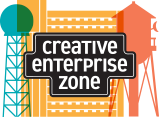The conundrum of creative space
A wide range of makers, innovators, artists and entrepreneurs are thriving in the Creative Enterprise Zone and have for many years. Initially, creatives were drawn here by the surplus of affordable space in the old commercial and industrial buildings that point to the past life of this area as an industrial center supported by the proximity to major shipping infrastructure like the rail yards and highways.
As many of these manufacturing and industrial operations gradually moved on, many of the spaces they left behind were filled by artists, artisans and other creative makers. The large, open, affordable, and usually unfinished spaces met their needs well, and the property owners were glad to have uses for the buildings that would have otherwise laid empty.
Five years ago, the building now occupied by C&E Lofts was home to dozens of artists and makers from a variety of disciplines—many of whom were well-regarded in their fields. When the building was sold to a developer who planned to turn it into high-end housing, it became clear that the conundrum that often faces creative communities would soon challenge this area, as well.
On one hand, developing old buildings and bringing new life, investment and energy to this area is a tremendous benefit to our community. On the other hand, these types of developments can quickly displace the creative energy that make the area desirable in the first place.
“It was the canary in the coal mine,” as Creative Enterprise Zone Action Committee Chair Catherine Day, often says of the C&E development. A group of concerned residents jumped into action and began to take a serious look at how we could preserve the creative character and resources of this area in the face of further development, partially spurred by the coming Green Line Light Rail.
Development was both inevitable and desirable, but figuring out how to preserve the creatives, artists and entrepreneurs that define and bring life to this area as the forces of progress and development continued was of paramount concern. This was the genesis of the Creative Enterprise Zone Action Committee, and these challenges continue to define our work.
It is tremendously exciting to see new developers in the Zone capitalizing on the creative capacity and character that defines this area by angling their projects to cater to creative uses. It shows that the value of this area as a creative hub is recognized and worth preserving. Major developments are expensive, however, and despite well-intentioned property owners’ best intentions to preserve creative enterprises and keep rent low, some will inevitably be displaced—some have been already.
It’s possible—even likely—that such creative-oriented developments will ultimately result in a net gain of creative enterprises here. We are thankful for the terrific developers that recognize the value of fostering a vibrant creative community and are working to both preserve and enhance what is already here.
But the conundrum holds true. Renowned urban writer and activist Jane Jacobs writes that, “old ideas can sometimes use new buildings. New ideas must use old buildings.” New creative enterprises often need old and affordable spaces, and developers have a bottom line they must consider, even when catering to the needs of creatives, artists and entrepreneurs. How do we preserve creative enterprises in the Zone and the access to the affordable space they often need, while encouraging and supporting the kind of development that benefits our community?
These are challenging questions, but are vital to the future success of not only the Creative Enterprise Zone, but the City of St. Paul, and other urban centers across the country. Once supported by large-scale manufacturing and industrial operations, the modern economy in St. Paul will continue to increasingly rely on creative enterprise. As we continue to transition to a maker economy, the question of how to balance the often conflicting needs of developers and creatives will need to be answered. We look forward to continuing to work with the constituents of the Creative Enterprise Zone, our elected officials, and developers to uncover innovative solutions.

